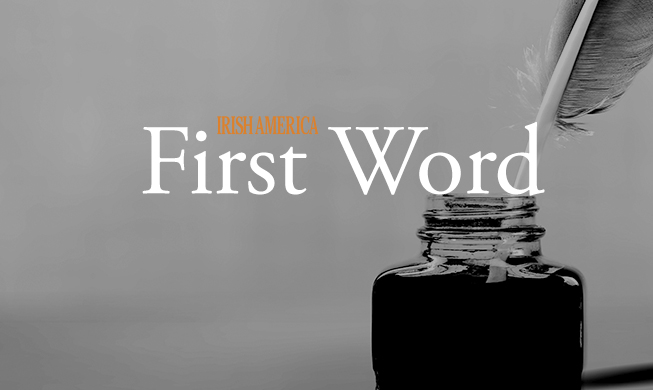
Reflecting on the past year, it appears to be a great time to be Irish.
And if we Irish are being perceived as “great” at the moment, our creative artists are largely responsible.
Time magazine’s “Best of 1996” picked Frank McCourt’s Angela’s Ashes as the best nonfiction book of the year, and it’s been on the best-seller list for weeks now. Remember that wonderful review that Pete Hamill (who has just been named editor of the New York Daily News) wrote for Irish America in the September/October issue?
In looking over Irish America for the past year, I see that we profiled quite a few of the artists — writers, musicians, movie-makers, dancers — who have brought us so much attention. There was our May/June interview with Nobel Prize-winning poet Seamus Heaney, our March/April feature on Thomas Cahill, author of How the Irish Saved Civilization (also on the best-seller list). In the July/August we reviewed some 50 new titles by Irish and Irish American authors, had a feature on New York Lincoln Center’s Samuel Beckett retrospective (also on Time’s list of the Best of Theater, 1996), and an interview with Michael Flatley, creator of the Riverdance sensation, and in our last issue we spoke to Neil Jordan on his movie Michael Collins.
Mixed in with our coverage of all the other wonderful happenings in the creative field we had features on the Irish studies programs at Notre Dame and Boston College, and our Top 100 stories of success in both the corporate and wider worlds, all stories indicating that yes, as the New York Times put it, “The Irish are Ascendent Again.” Even the story of the Famine, which we focused on a lot last year, proved our great tenacity and ability to overcome.
But for all the pride of place and the success that we Irish now enjoy, at least partly by sharing the spotlight with our artists, there is a dark underlayer, a subtext to the story, that never goes away, that is covered in every issue of Irish America — the story of Northern Ireland.
Both Déaglan de Bréadún and Eoin McKiernan (our conscience on the back page whom we refuse to allow to retire) writing in this issue show that it’s an ongoing problem.
Which brings me to Some Mother’s Son, a movie on the 1981 Hunger Strike that focuses our attention again on the fate of the Nationalist community in the North.
In finding a way to bring this tragedy, which took the lives of ten young men, to the screen, director and writer Terry George, and his creative team, including Fionnula Flanagan, our cover story, have shown their true measure as artists.
Perhaps what makes a good artist “great” is when they remind us that things are not so great. When they take the material — the baggage of society — and, infusing it with their own personal experience, present it in such a way that, no matter how excruciating the story, it’s bearable, and we walk away with just the right mix of guilt and discomfort, enlightenment and understanding.
George uses talent and his experience of growing up in the North in the same era as Bobby Sands, and his own time in prison, to focus our attention on the North, and he does it in such a way that the story will have wide appeal. People who know nothing of the straggle will come away with an awareness of the pain that was suffered, and a better understanding of the tragedy of both the Hunger Strike, and why the North is such an ongoing problem.
Frank McCourt in Angela’s Ashes made lyrical prose out of a rotten, poverty-filled childhood in first Brooklyn and then Limerick in the ’30s, and in so doing made us look around and see the Angelas of the ’90s, who, like his mother, cope as best they can in the poverty that exists in our Irish and American cities today.
So, “cool” as it is to be Irish just now, these fine artists, by at-once both bringing us accolades and taking some of the glow out of our “greatness” through shining a light on our dark places, remind us that it’s not yet time to sit on our laurels.
Editor’s Note: This article was originally published in the January/February 1997 issue of Irish America. ⬥


Leave a Reply